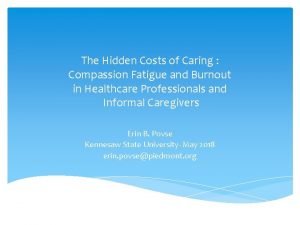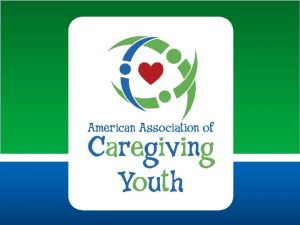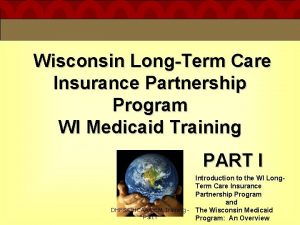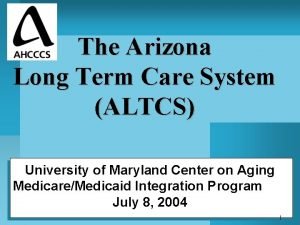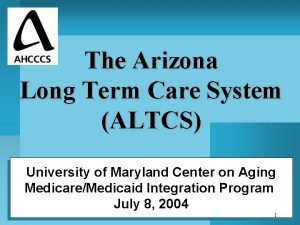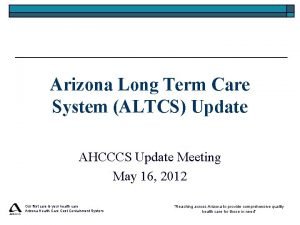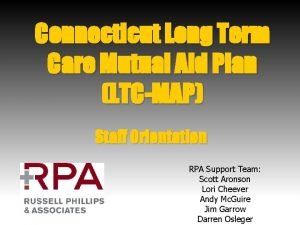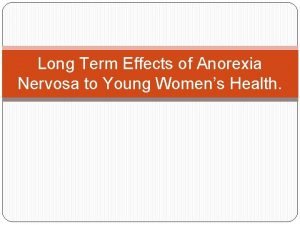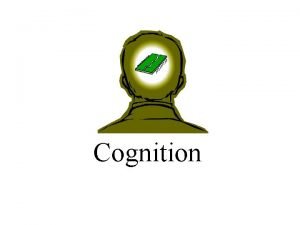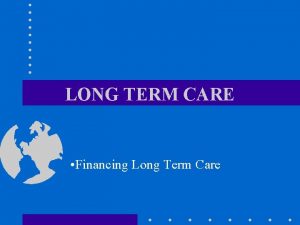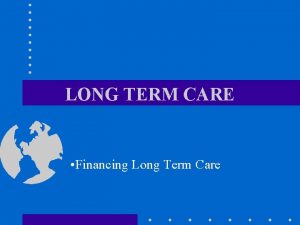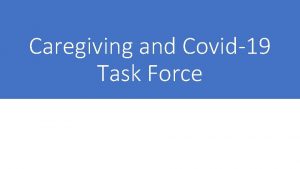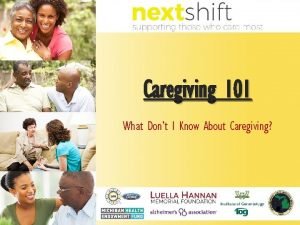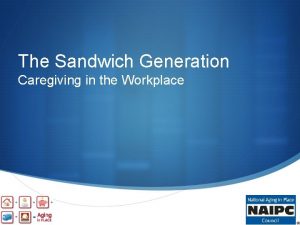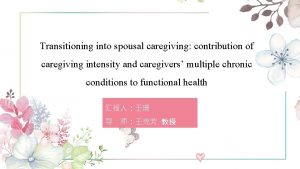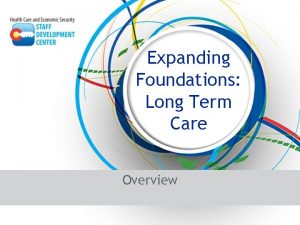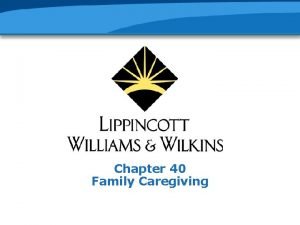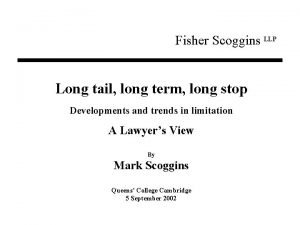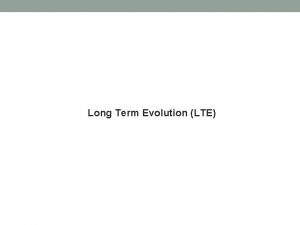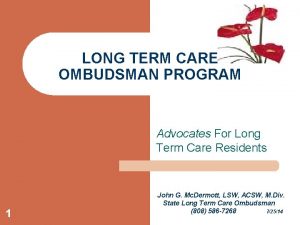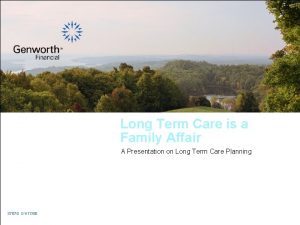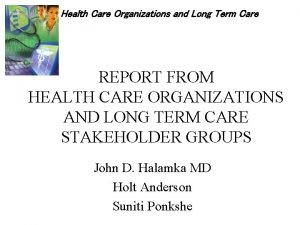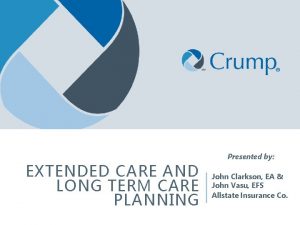Long Term Care Family Caregiving and the Law


























- Slides: 26

Long Term Care, Family Caregiving and the Law of Succession Part One Josephine Gittler The Aging Population, Alzheimer’s and Other Dementias: Law and Public Policy University of Iowa College of Law March 29, 2012 1

The Aging Population and Long Term Care 2

Needs of Aging Population Chronic Diseases & Disabilities Functional Limitations Long Term Care Services & Supports 3

The Aging Population: Chronic Diseases & Disabilities Ø Most older people have at lest one chronic disease, e. g. heart disease, cancer, or diabetes. Ø Physical disabilities increase with age, e. g. vision, hearing, and mobility impairments. Ø Older persons, particularly the “oldest old” are at risk for Alzheimer’s Disease and other dementias. 4

The Aging Population: Functional and Cognitive Limitations Ø As a result of chronic diseases and disabilities, a substantial proportion of the aging population, especially the “oldest old” have functional and cognitive limitations. Ø Functional and cognitive limitations may result in an inability to perform or difficulty in performing activities of daily living (ADLs) and instrumental activities of daily living (IADLs). 5

The Aging Population: Long Term Care Ø Older persons with functional and cognitive limitations frequently need long term care (LTC). Ø Estimated 70% of persons 65+ will need LTC at some time, for average of three years. Ø Persons 85+ are 4 times as likely to need LTC. 6

The Aging Population: Long Term Care Ø Home-based: Personal care Home health care Friendly visitor from senior services Emergency response services Ø Community-based: Adult day care Senior centers Meals programs Transportation service Ø Facility-based (institutional): Ø Nursing homes Ø Assisted-living facilities 7

Family Caregiving 8

Extent of Informal Family Caregiving Ø Informal family caregivers are the most important source of unpaid LTC. Ø An estimated 1 in 6 adults provide unpaid LTC to older adult relatives (or friends). Ø It is estimated there were 54. 6 to 68. 6 million caregivers providing care to predominantly older adult family members in 2009. 9

Nature of Family Caregiving Family caregivers predominantly provide assistance with ADLs and IADLs. 10

11

Characteristics of Family Caregivers The typical caregiver is: Ø a woman Ø age 49 Ø employed outside the home Ø providing care to widowed mother 12

From: 2012 Alzheimer’s Disease Facts and Figures 13

Burden of Family Caregiving According to a 2009 national survey: over 50% of caregivers reported a medium to high level of burden 14

15

Family Caregiving: Health & Psychosocial Consequences Ø Caregiving more likely to have poor physical and mental health than non-caregivers. Ø Caregiving may adversely affect family relationship and lead to social isolation. 16

17

Family Caregiving: Economic Consequences Ø Caregiving often has negative impact on employment status of caregiver, leading to lost earnings and diminished social security and pension benefits and retirement savings. Ø Caregivers often incur out of pocket expenses in connection with caregiving. 18

19

Family Caregiving: Economic Value Estimates of economic value of unpaid family caregiving in 2009 range from $199 billion to $450 billion. 20

Formal Paid Caregiving 21

Cost of LTC Provision By Paid Formal Caregivers In 2011, the Medicare annual rate was: Ø$77, 745 for private nursing home room Ø$70, 445 for semi-private nursing home room Ø$39, 135 for assisted-living facility Ø$43, 472 for home health aide services Ø$41, 184 for homemaker services 22

Sources of LTC Financing Ø Federal/State Medicaid program Ø Federal Medicare program Ø Out of pocket expenditures by care recipient Ø LTC insurance 23

24

Medicaid LTC Expenditures Ø Federal/State Medicaid is single largest source of funding formal paid LTC, accounting for 40% of all LTC expenditures. Ø LTC is a major component of overall Medicaid spending Ø Medicaid spending is growing at annual rates exceeding state revenues and national economic growth. 25

Rationale for Proposal Public policy and law should recognize and support contribution that families make to meeting growing need for LTC. Without unpaid family caregiving, already strained state and federal budgets would have to increase enormously to cover costs of LTC. 26
 Ofcfbrazil
Ofcfbrazil American association of caregiving youth
American association of caregiving youth Short term planning and long term planning
Short term planning and long term planning Short term human resources
Short term human resources Difference between long term and short term liabilities
Difference between long term and short term liabilities Difference between long term and short term liabilities
Difference between long term and short term liabilities Long term goal examples
Long term goal examples Long term and short term financial planning
Long term and short term financial planning Long term memory vs short term memory
Long term memory vs short term memory Short short short long long long short short short
Short short short long long long short short short Once upon a time there was a little red fox
Once upon a time there was a little red fox Từ ngữ thể hiện lòng nhân hậu
Từ ngữ thể hiện lòng nhân hậu Institutional medicaid
Institutional medicaid Altcs arizona long term care
Altcs arizona long term care Arizona long term care system (altcs)
Arizona long term care system (altcs) Ahcccs altcs
Ahcccs altcs Ct mutual aid plan
Ct mutual aid plan Newton's first law and second law and third law
Newton's first law and second law and third law Si unit of newton's first law
Si unit of newton's first law Primary secondary tertiary health care
Primary secondary tertiary health care Boyle's law charles law avogadro's law
Boyle's law charles law avogadro's law Boyle's law charles law avogadro's law
Boyle's law charles law avogadro's law Long term storage and retrieval
Long term storage and retrieval Anorexia nervosa short term effects
Anorexia nervosa short term effects Memory encoding
Memory encoding Long term objectives and strategies
Long term objectives and strategies Long-term debt preferred stock and common stock
Long-term debt preferred stock and common stock
